1948: ..........
Part 2: 1948 as it could have been
Author
- Henri Greuter
Date
- May 19, 2020
Related articles
- 1948: .........., by Henri Greuter
- 1964 Indy 500 - The Indy 1964 second-lap disaster: closing in on the truth, by Henri Greuter
- 1992 Indy 500 - An Indy record deliberately listed incorrectly, by Henri Greuter
- 1995 Indy 500 - Rough justice, but justice nonetheless, by Henri Greuter
- 1996 Indy 500 - The 239.260 car, by Henri Greuter
Who?Duke Nalon What?Kurtis-Winfield 'Novi' Where?IMS Museum When?2016 |
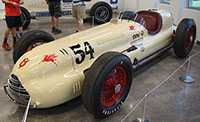 |
Why?
But what if...
As mentioned in the introduction, I had a meeting in the summer of 2017 in which I discussed some controversial Indy finishes. After that the discussion went on to races with unexpected lead changes in the final stages. So that was how 1948 got mentioned, and with it: the Novi. I was then asked which race had been the one in which a Novi had been closest to victory. Because of avoiding speculation about what might have happened in most races (Novis retired early on so often...), the one I gave it the best chance ever was Duke's 1948 race: good strategy applied by Duke, and up with the leaders close to the end. The topic of Duke leading at the time of his stop or not also came up and I said that had not been the case. And then I was asked a simple question: but what if Duke hadn't made that extra stop, would he have been declared the winner?
I was silent for a few seconds as the implications of such a scenario hit me. Then it dawned on me that there were so many unanswered questions. Have those ever been asked?
Eventually, my conclusion had to be that I couldn't answer the question at that particular moment, simply because of too many unknown factors. But that depending on all those factors it was possible that the final scenario could have been one similar to something that would happen at a different American race track 49 years and one week later. Now, if such a scenario had indeed happened in 1948 already, it doesn't mean it would have had the same consequences as was the case 49 year later. But it would still have been extremely embarrassing and put 1948 among the most controversial races ever.
Why? Well, I admit that it's going to take some brain gymnastics to fully comprehend the scenes that could have been. But I will do my best to cover all the situations as best as I can. I hope you can follow my thinking and reasoning.
Letting our imagination run free and combine it with all the known facts
Our starting point has to be the situation on Race Day itself according to the IMS Timing & Scoring on lap 167, when it was announced that Duke was leading the event.
I have found no definitive evidence in print that before or on the moment of Duke making his extra fuel stop Timing & Scoring was aware of their scoring error and had corrected themselves over the PA as well as on the scoreboard.
Neither have I found any evidence that they had been aware of the fact in the final stages of the race after Duke's stop, let alone that the crowd was informed about the fact that Rose was leading the race with a far greater margin (a full lap to be exactly) than based on the fact that he had passed Nalon when Duke was stalled in the pits. From what I can make of the situation as it was known at that moment, it is certain that the crowd was informed correctly who was leading the race at least after Mauri Rose had passed Duke Nalon while the latter was in the pits.
But what if Duke hadn't made that stop and could have gone on to the end while maintaining the pace he kept in the laps before that fateful pitstop? And crucially, while the Timing & Scoring error hadn't been detected yet? Then add the bare fact that Rose being the actual leader wasn't announced before the end of the race. What would such a scenario have led to?
For this we would have answer these two questions: What was Duke's pace compared to Mauri Rose at that moment? And was Mauri closing in on Duke, yes or no?
In other words, back to the history files to get our answers based on the data available to us.
Now we have to go back to the situation in the race as it truly was. The reports I found stated that by the time Duke made that fateful extra stop for fuel he was some 28 seconds behind Rose yet lapped some 1 to 1.5 seconds quicker than Rose. However, I couldn't find any data of fastest laps at the race speeds achieved by either drivers.
For our first conclusion, however, this is no problem. Because if we convert these data (Duke some 28 seconds behind Rose and lapping 1 to 1.5 seconds faster) to the situation as it was believed to be during the race, Duke was ahead of Rose while extending his lead. His supposed lead can be calculated as having been something like 45 seconds.
In other words: if Timing & Scoring hadn't yet sorted out their error in the very final phase of the race and if Duke hadn't made his additional stop, he would have been given the chequered flag and celebrated as the winner of the race. That is, if Lou Moore and Mauri Rose wouldn't have protested the results instantly and made a scene near Victory Lane in the same way Arie Luyendyk had done at the Texas Motor Speedway in 1997. (Arie did so because of being denied victory of which he was certain. Instead it was handed to Billy Boat who drove for a certain AJ Foyt from Houston, TX. It resulted in an embarrassing fistfight between Arie and AJ in Victory Lane. The only fact more embarrassing than that, at least for USAC, was that Arie was correct and USAC was forced to adjust the race results the following morning.)
Back to 1948, we know now that the following day when the final results were posted the timing error had been discovered, the error that in our hypothetical situation would have led to the fact that - because of Duke losing a lap - Mauri Rose had to be declared the winner. It is actually more correct that it wasn't so much a case of Duke losing a lap but Rose getting (back?) another lap.
In other words, having another winner on Monday than the one celebrated in Victory Lane on Sunday sends shades of Indy in May 1981 (when on Monday morning Mario Andretti was declared the winner instead of Bobby Unser) and Texas in June 1997 (when Arie Luyendyk was declared the real winner after all).
But one may wonder what mayhem and upset would have followed if AAA and the Speedway had been forced to take away an oh so popular victory from Duke and the Novi!
All of that could have been avoided if Duke's single planned pitstop had gone according to plan, the car topped off and Duke managing to pass Rose on track in those final laps...
Had Duke passed Rose, the crowd would have thought that Duke had put Rose a full lap down whereas instead he would have taken the lead from Rose. And as long as he had remained in front he would have been the winner, even if his winning advantage was corrected from over a lap to just a small time deficit.
As mentioned before, the true situation was that Duke was some 28 seconds behind yet lapping 1 to 1.5 seconds quicker that Rose. That 28-second time deficit becomes even more painful knowing that Rose's stop took 1:20 while Duke's stop lasted 1:48. So 28 seconds longer...
Continuing at a rate of up to 1 to 1.5 seconds faster, it would have taken Duke anything between 21 to 28 laps to catch Rose, assuming Rose would continue at the same speed as well. In other words, at that pace Duke wouldn't have passed Rose in those final 15 laps. I have no validated data about the fastest lap speeds for both men, if they had room to increase their speeds and if this could have given Duke the opportunity to pass Rose after all.
The best estimation of race lap speeds I found for Duke is the following. He was the race leader halfway, so after 100 laps, shortly before his single planned pitstop. The 1948 Clymer contains a 50-mile lap interval scoreboard with the leader's average speed at that moment. If I use Duke's data at 250 miles I get an average lap time over that distance of 1:14:79.
Then another article in the 1948 Clymer mentions that Nalon and Bill Holland were lapping at about 125mph around the 180-lap mark in the race. Such a speed would mean lap times of about 1:12.
This same interval scoreboard used for calculating Duke's average lap speed at 250 miles can also be used for Mauri Rose's speeds at 400, 450 and 500 miles when he was leading the race. Some more calculation tells us the kind of lap speeds he managed in the 20-lap intervals between those distances:
| Miles | Leader | Avg lap time at distance (m:ss.xx) | Avg lap time for interval (m:ss.xx) |
| 350 | Horn | 1:15.46 | |
| 400 | Rose | 1:15.46 | Better than 1:15.46 |
| 450 | Rose | 1:15.42 | 1:15.18 |
| 500 | Rose | 1:15.12 | 1:12.35 |
NB1: Lap speed is in min:sec and 1/100th of a second.
NB2: Lap speed for the interval between 350 and 400 miles is calculated for the time difference between the two lap leaders at those distances. Given the fact that Rose was behind Horn, Rose started the interval after Horn and thus covered the interval faster than the calculated time valid for the race leader, hence a faster average lap time.
Most telling is the average lap time for Mauri Rose between 450 and 500 miles. Rose was lapping in the 1:12 bracket, which is matching Duke's reported lap times at around 180 laps.
Then we have the report of the actual situation at the time of Duke's emergency stop, saying he was 27 seconds behind Rose but lapping 1 to 1.5 seconds faster.
Now, if Rose was lapping at about 1:12.3, does this mean that Duke was lapping at speeds with lap times of low 1:11 and high 1:10s? I have no idea if we can make that conclusion and I don't have access to actual data of individual lap times.
In order to get an idea of how fast the Novi could have been, the only data we can use are the qualifying times, and compare these with the race figures. For good measure we will look at Mauri Rose's numbers as well.
| Driver | Qual avg (mph) | Avg lap time | Race avg (mph) | Avg lap time |
| Mauri Rose | 129.129 | 1:09.697 | 119.814 | 1:15.115 |
| Duke Nalon | 131.603 | 1:08.387 | 118.034 | 1:16:245 |
The stat proves that the Novi had been quicker over a lap during qualifying than the Blue Crown.
But then this is not a figure from 1948 but from one year later. In 1949, Duke started the race from pole but had a big fiery crash on lap 23. Up until that he had taken off like a rocket, reportedly lapping with an average of about 125mph (which means lap times of about 1:12), and that with a car heavy from a full fuel load.
But would such speeds with lap times below 1:12 have been possible in the final phase of the race when it really mattered? On tyres that had a been put under massive stress and were at the end of their lifetime? And could that speed difference have been big enough for Duke to pass Rose on track and secure the lead?
At first sight this doesn't appear very likely, but let's take a more detailed look.
The first we need to be aware of is that, if necessary and under the right conditions, Duke's Novi could be the fastest car on track, at least over short distances. However, that came with the penalty of high fuel consumption and tyre wear. More on the Novi's fuel consumption later on.
On lap 180, Duke was driving on tyres with some 80 laps on them already. Circumstances had been tough on these tyres. In theory, they had been used on a car fully loaded with 112 gallons (424 litres) of fuel. So when Duke returned to the race he was theoretically driving the car with additional fuel weight and additional stress on the tyres because of that extra weight.
During his first stint (from start to lap 101) Duke applied what I still believe to be the only strategy that gave him a chance to do well in the race: not going flat-out early on when the car was at its heaviest, with high speeds wreaking even more havoc on the tyres. In his second stint he had done the same. The question remains if he had preserved the tyres well enough to be able to do reach speeds approaching qualifying speeds in the final stages of the race. This is not questioning Duke's abilities as a driver, it is merely questioning if it was possible at all to drive half the race on a single set of tyres with the strategy of preserving the tyres for the final part of the race and increasing speeds accordingly. If possible, could Duke have sped up fast enough to close the gap to Rose? I have no idea but I don't think this is likely.
All this is only in theory, as the state and condition of the Novi during that phase of the race were a bit different.
Duke was driving on the assumption of having a fully filled up fuel tank, yet he wasn't. Based on the figures available we can deduct that the Novi required a little over a gallon per lap, so make that 4.1 litres. His fuel issues arose with 16 laps to go, so he would have required something between 16 to 20 additional gallons (66 to 82 litres). Staying on the safe side, and in order to allow for some hot laps in the final phase of the race, let's argue that Duke would have needed 25 gallons (95 litres) to make it to the end. So my estimate is that Duke carried some 25 gallons (95 litres) less fuel on board than was intended.
The Novi ran on (reportedly) a blend of 80% methanol and 20% other components, among those toluene. Given the density of methanol (0.793 kg/l) and toluene (0.87 kg/l) I estimate the weight of a litre of the fuel blend to be 0.81 kg/l. So Duke had driven his second stint (from lap 101 on) with 77kgs less weight than he was actually supposed to carry.
Which raises the question if Duke could have been in the same position he eventually found himself in towards the end of the race. What would tyre wear have been on the car? Had less weight made the car easier to handle and a bit faster? Could Nalon have closed up to Rose in the way he had done with a car that was 77kgs heavier? And could his tyres have been in a near similar state?
I can't answer that question but my gut feeling says that Duke could not have been as close to Rose as he was. And if he had been after all, his tyres would have been more worn off which would have compromised his speeds in that final stage of the race.
So I think it is fairly safe to conclude that it was not impossible for Duke to get closer to Rose but actually passing him in that final phase of the race, however, seems very unlikely.
For the record, C. Lee Norquest gave an overview of the actual time differences between Rose and Nalon in his Fabulous Novi Story. To give an indication: after Rose made his stop he led Nalon by 34 seconds on lap 130. This grew to 38 seconds on lap 160 but on lap 180 the time difference was down to 28.35 seconds. So the time difference had been fairly stable, even though Duke gained some 10 seconds between laps 160 and 180.
It will always remain a mystery how much of this time difference was affected by the fact that Duke was told he was leading, so consolidating what he believed to be a leading margin instead of failing to make up time to the leader.
Until now we have focused on Duke and the Novi but haven't devoted any attention to the other party in this battle. What would Mauri Rose have done if he knew that the Novi was getting closer and closer?
To get to an answer, first let me give you a few additional details about Rose's driving career. In 1941, when he took over the car driven by Floyd Davis, he was over 2.5 minutes away from the lead. He worked his way up to the lead and eventually finished first. Then we have already seen how in 1947, while in second place behind his team mate Bill Holland, he disobeyed team orders in an attempt to be victorious again, second not being good enough for him.
Running a bit ahead of time and into the future, exactly the same situation occurred in 1949, with Rose running second behind his team mate Holland in the closing stages of the race. Again, team orders came out to the drivers to slow down and hold station, and Rose ignored those one more time, second once again not good enough for him. And that is where the similarities with 1947 end.
This time Holland was fully aware of the fact that he was leading his team mate. Having learned a lesson about Mauri Rose as a team player, Holland also refused to follow team orders, making real Lou Moore's nightmare of his two drivers battling each other instead of making sure of gaining him a maximum pay-day. His nightmare of losing almost everything partly came true when Rose's car broke down with eight laps to go. What could have been 2nd-place money to split became 13th-place money instead.
Now that was hurting. Assuming that Rose still got 40% of the prize money instead of Moore retaining 60% of $18,250 (around $10,950), he now got 60% of only $2605, meaning some $1500. Rose's actions had cost Moore over $9000. The third driver of the team that year, George Connor, climbing a spot from fourth to third with the corresponding increase of around $3000 (with at least around $1800 as Moore's share) couldn't ease the pain.
On top of that, directy after the race Rose complained to Moore about the fact that his car had let him down! Not a very wise thing to do right after having ignored his boss' orders to take it easy and bring the car home. Understandably Moore went ballistic and fired Rose on the spot.
In other words: certainly in the post-war years, Mauri Rose was not much of a team player, if anything. Instead, driven by personal (prize money-inspired) reasons he went for victory whenever possible, up to the point that he rather 'went down with the ship after a maximum effort to win' than settle for a decent classification.
Knowing this, imagine the most likely thing Mauri Rose would do when leading the race and a faster car comes up behind him, with him knowing that he wasn't driving his car at its maximum speed yet...
All of this combined leads me to conclude that even if Duke Nalon hadn't been forced into making that late stop for fuel, the chances for him to pass Mauri Rose and become the winner of the 1948 Indianapolis 500 appear very unlikely.
But there is one joker card left.
What if Duke had been aware of not leading but instead was correctly informed by his pits that he was in second place?
Now, for the record, Norquest tells in his Fabulous Novi Story that somewhere after lap 160 his crew had given Nalon the signal that he was in second place. This is the only reference I have found about Duke actually being aware of the true situation. Which may perhaps go to explain why and how Duke had made up those ten seconds on Rose between lap 160 and 180.
If Nalon had known all the time that he was in second place (while in fact he was still leading) we can assume that Duke would have raised his speed even more to take the fight to Rose. In that case he would likely have run into fuel problems and may well have had to make his extra stop at least one lap and perhaps a few laps earlier.
If the fuel tank had been filled entirely, then I am not sure that Duke would have been able to be fast enough to close up without compromising his tyres. Another source of concern could be the fuel amount. Even after receiving a full fuel tank, would it have been enough to cover little under half a race if the speed had been increased? This assuming that the tyres would have held up to begin with?
Whatever scenario can be brought up, at least for me there is little to no chance of coming up with the scenario in which Duke stood a chance of having beaten Mauri Rose.
So I fear that it is time to once and for all accept - if that hasn't been done earlier already - that even in 1948, the year of the Novi's best-ever finish, its efforts were still not good enough to see a front-wheel-drive Novi in Victory Lane.
Must we regret that additional fuel stop as the reason for Nalon losing the race? As far as I can figure out, it didn't make any difference for the eventual outcome. Mauri Rose would have been the winner, with or without that extra stop.
Perhaps there is a reason to be happy that this stop was necessary. Had it not taken place, it could have resulted in a situation of Duke celebrated as the winner, only to be stripped from victory the following day when the final results were published. This would certainly have caused a major embarrassment for the Speedway and sanctioning body AAA. Also, it would have been another painful moment for the Lew Welch-owned team that was struck with so much tragedy and ill fortune that year already.
So maybe it is for the better that things happened the way they did.
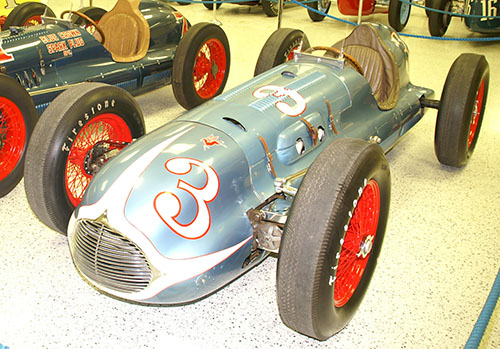
Mauri Rose's Blue Crown has survived the times and went into the collection of the Indianapolis Motor Speedway Museum. It has been restored into the colours it wore in 1948. The car is shown here pictured in the IMS Museum in May 2011 when it was part of the largest exhibition of race winners ever in recent history. Partly visible next to it in dark blue is the sister car, in the colours the car wore in 1949 when Bill Holland drove it to victory. A rare moment in history to see these two legendary cars standing next to each other again. (photo HG)
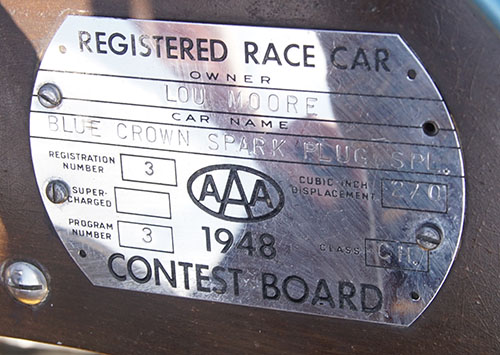
The restored Rose Blue Crown even carries the AAA shield that was given to the car for identification purposes.
Picture taken on Race Day 2016. (photo HG)
A brief look at what caused 'that' extra stop
Finally, what about the one incident that made sure that the 1948 finish could no longer be controversial? I mentioned two causes for Duke running short on fuel - the car was either shortfuelled or the intercooler connection was leaking.
The leaking intercooler story has been told to me by two independent sources, one of them 'Radio' Gardner himself, the mechanic who carried out the actual refuelling.
In a discussion with Indy historian Dr. Tom Lucas, Tom pointed out that 'Radio' had enough reasons to refuse the blame for making a mistake. But even if 'Radio' hadn't properly filled up the Novi there are enough reasons for him to be excused. The question must be asked how often that year the opportunity or even the need had arisen to fill the Novi up to the brim and verify whether the tank was indeed entirely filled up? Let alone performing such a test in a pitlane under simulated Race Day conditions?
In other words: how often did the team verify the full effects of filling the tank under pressure, as was necessary during the race, and thus be aware of a large gas bubble eventually coming into existence in the tank?
Based on the authority of the other source about the leaking intercooler, both Lucas and I concluded that this explanation can't be ignored and dismissed entirely. But we also agreed on the fact that if the Novi was indeed shortfuelled by 'Radio' he can't be blamed for it. It is very unlikely that he and/or or other people in the team were fully aware of the effects of the high-pressure refuelling as they appeared to have shown up later on in the race. Knowing his dedication to the team and cars he worked on, I am confident to say that "Radio" would have done anything to limit the effects to an absolute minimum, had he been aware of the problem, and in doing so would have made sure that Duke left the pits with a tank that was as full as it could possibly be.
Regrettably, however, it appears that even a fuel stop that had gone entirely to according to plan was likely not enough to secure victory.
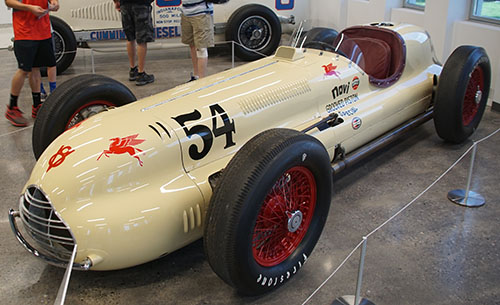
Duke's Novi has survived as well and is in the possession of the Indianapolis Motor Speedway Museum from around 1960. Shortly before he went bankrupt Lew Welch donated the car to the Museum. Somewhere between 1983 and 1988 the car was restored into the colours it carried in 1948. The restoration is not entirely correct to the last detail, as the disc brakes on the car as seen here were installed in 1955. Also, the air scoop of the carburettor and supercharger seen here is from later years. And, sadly, the car is not in running condition as the engine is a shell. But other than that, it is as close as you can get to the car as it was in 1948. For a very long time it was one of the few non-race-winning cars on near permanent display on the Museum floor, but in recent years it wasn't exhibited for certain periods of time. This picture was taken the last time I set eyes on the car, in May 2016. (photo HG)
Rounding off
Already mentioned in the introduction, I had in mind to publish the original version of this piece in May 2018, to commemorate the 70th anniversary of the events described. Eventually, when it was ready to go online after all, two years later, I then decided to give it the publication date of May 19, 2020. Because 72 is not a really memorable figure for an anniversary, except for one historic fact, because May 19, 2020 is the 72th anniversary of the first ever laps of Duke Nalon in the Novi. The birth of a spine-tingling combination of car and driver in Indy history, even today. An appropriate day to go online with a piece like this.
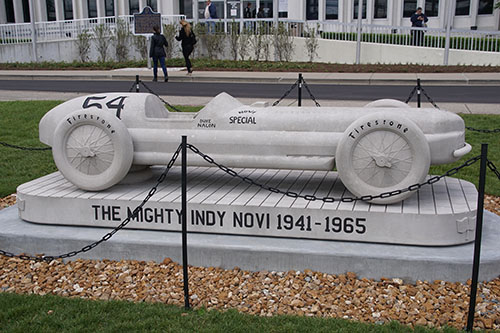
Mr Eddie Evans of Bedford, IN (1931-2006) owned a company in the limestone industry. A big-time race fan who for a while owned his own car museum, he ordered several racing cars be carved out of limestone. One of the most famous ones in the collection was this half-scale tribute to Duke Nalon and the Novi as the highlight of the Novi legend. The Evans family donated this 'limestone milestone' to the Indianapolis Motor Speedway on May 1, 2016. Since then it stands in front of the Museum building. This picture was taken early May 2016. (photo HG)
This brings me to my final observations, and for those I will take you back to the very start of this article, that song about 1948, the Dutch interpretation of Gilbert O'Sullivan's Alone again, naturally.
That line 'Alone again, naturally' is very much the chorus of the lyrics. In the Dutch translation it a line that returned all season long. In fact, like the song on which it was inspired, the line is often believed to be the title of the song, which is not the case. However, this chorus line somehow reminded me of one of the participants of the story. In Dutch the line reads:
"Toen was geluk heel gewoon."
In the spirit of the full song, the line should be translated into something like:
"When good fortune was a common thing" or "When happiness was a common thing".
That's because the Dutch word geluk can also be translated with luck. Now if anything was all but common for the Novi cars and their drivers, it is exactly that: luck.
Then, finally, this article is dedicated to three people of whom I have had the privilege to call my friends. Two men are among my heroes. I had the pleasure of meeting them on location and owe a lot to them. Thanks for everything to my friends 'Duke' Nalon and 'Radio' Gardner, men who made the history of which I have had the privilege to be part of it being documented, here and in print.
I owe being part of a project that resulted in The Novi Legend appearing in print to two other people. I teamed up with these people after having written and printed (in late 1987) my first-ever English manuscript about the Novi legend. It was deemed good enough to prove that the three of us could make this project possible eventually.
In that first-ever English manuscript the 1948 chapter carried the very same title as this story, but it also carried a subtitle.

The title and subtitle for the 1948 chapter as it appeared in the print of my first English Novi manuscript. (photo HG)
To this day, this still sums up how I feel about 1948 for the Novi team.
This English manuscript got a worthy follow-up and was made available in large numbers to the general public. I owe that to these two people, one of whom is no longer alive at the time of writing. She was a friend of both 'Duke' and 'Radio', and effectively the third unnamed author of the books co-written by her husband George and me. So, I also dedicate this to my beloved friend, Barbara Peters.
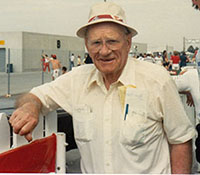
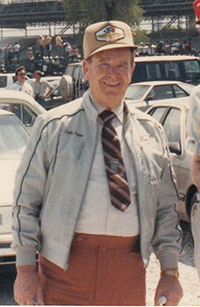
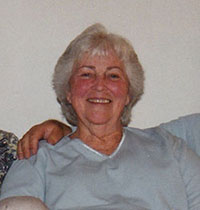
James Bell 'Radio' Gardner (in 1988), Dennis "Duke" Nalon (in 1988), Barbara Peters (in 2000)
Rest in peace, my dear old friends, thanks for the memories and everything else.
